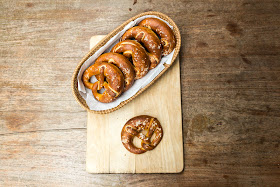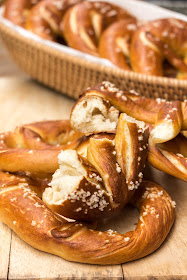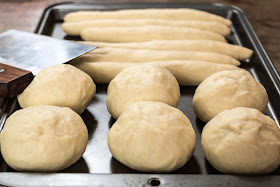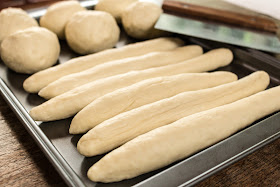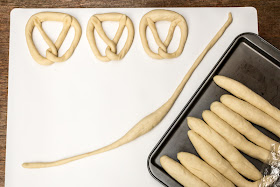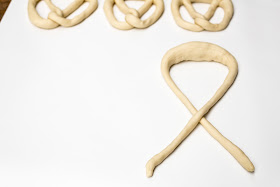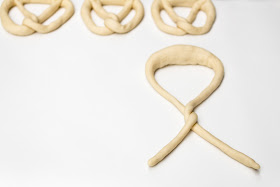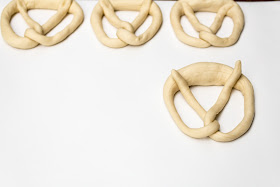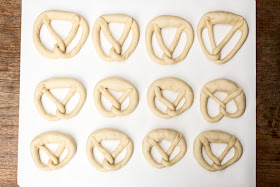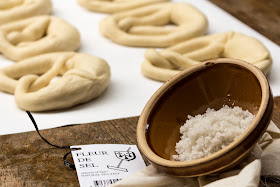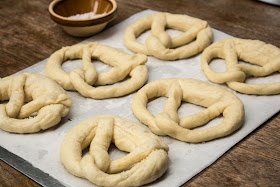I had a massive pretzel craving the other day. I really wanted a big, soft, crunchy, dense, crispy, salty, chewy pretzel. And I had no idea where to get one in Hong Kong. (Please let me know if you do!)
So I had to make my own to satisfy my desires.
I'd vaguely remembered the process of making pretzels, as it had been the final technical challenge of the Great British Bake Off last year. There was an unusual step of boiling the dough in some baking soda water before baking it.
A quick youtube search, which involved watching some very lovely, and very entertaining German-speaking bakers, confirmed that this boiling step was indeed necessary. However, my lack of understanding of German meant that I couldn't gather a recipe.
So in the end, I chose to base my recipe on this one on BBC Good Food: "Authentic German Pretzels".
It's a recipe that requires a little more time and preparation. But, these pretzels taste as good as they look, and are worth every oomph of effort!
You need to prepare a sponge first. What's that? Well, it's just a mixture of some of the flour and water and all of the yeast used in a recipe, which is then left to ferment. The purpose of this is do develop the taste of the pretzels. It's a similar idea to sourdough starters! I left mine overnight, but most people say 5 hours is enough if you're in a hurry!
Then add in the the rest of the ingredients and mix and knead well. You can cheat here if you've got a bread maker or dough hook on a stand mixer that will do the mixing! The dough is quite a dry dough, and once it's all mixed together and incorporated nicely, it shouldn't stick to your hands and you won't need any extra flour to dust your work surface. Shape it into a nice big ball, pop it in a bowl, cover and leave to rise.
It's ready when the dough bounces back completely but gently after you push a finger into it. Give a a good couple of punches to knock out some air then divide it into 12 even portions.
Shape each portion into smooth round balls first. Keep all the dough (apart from the piece you are handling, of course!) covered lightly with some cling film. Then roll out each ball into a thick log.
Doing the shaping step by step from big dough ball -> small dough balls -> thick short logs -> before finally making a long rope of dough makes it easier to stretch the dough. The dough has some time to rest and adjust to its new shape before it has to stretch again. Otherwise, you might find the dough being uncooperative, and creeping back to the centre after you've rolled it out.
Once you've got all your thick pretzel dough logs, then you can start to roll out long ropes to create a traditional pretzel knot. Pretzels are usually thicker in the middle, so leave the 10cm in the centre, and use both hands to gently roll and stretch the ends out. Apply a gentle pressure from the inside to the outside, and spread the dough out until it's 40-50cm long.
Ideally, it should be fatter in the middle and taper out towards both ends.
Now for pretzel knot tying!
The videos I saw on youtube tie the pretzel knots the traditional (I assume) and quick way. It looks easier than it is, but it's fun and I think that you should definitely watch videos like these, and try it yourself!
- Hold up the pretzel rope by its ends, one in each hand, so that it forms a 'U' shape.
- Keeping both hands in the same place (i.e. don't cross them over each other), flick the rope and swing the bottom of the 'U' shape, so that it twists and crosses over on itself, forming a double twist.
- Quickly, before the double twist untwists, lay it down on your work surface, without letting go of the ends.
- Lift the ends and fold the knot back up on the pretzel and press down firmly to secure the ends.
Remember, practice makes perfect!
If it's not happening though, don't worry, there's a backup plan!
Step 1: Place rope in an upside down 'U' shape, lift both ends, and cross your right hand over your left, and your left under your right, so that the ends have switched places.
Step 2: Lift both ends again and cross your right over your left, left under right, again, so you get a double twist.
Step 3: Lift both ends and flip the knot back onto the pretzel. Press the ends in to secure.
Repeat with all the pretzel dough logs. Then leave all the pretzel knots out, uncovered, to rise again and form a crust while you make the baking soda solution.
The baking soda solution, is just baking soda (bicarbonate of soda), dissolved in some water. I would use cold water, and bring it to the boil, because the heat makes the baking soda really fizz, so it's easier to control and less dangerous if you don't take a shortcut.
Apparently, they use lye in a commercial setting, which is caustic soda (NaOH - sodium hydroxide). It's really not something you want to be using at home (unless you're unblocking sinks and drains!), and baking soda is much more friendly and will do the trick.
When the solution is boiling, dip in the pretzels for 5 seconds, then flip and do 5 seconds on the other side. I did mine one at a time, because 5 seconds really is a quick 'dip' and I wouldn't have been able to manage any more.
I wanted simple salted pretzels, so I just had some fleur de sel ready to sprinkle onto my boiled, wet pretzel knots. Coarse, unrefined salt works best for sprinkling on top because it doesn't dissolve. And try to remember to sprinkle while it's wet, so it sticks on better!
Now I didn't slash my pretzels. Some people do, because they find that this controls the pretzels rise in the oven, and the way the pretzel crust splits. You will get a nice, even, clean split if you deeply slash the pretzel at the thickest part. However, I don't think it's necessary, and if you don't, you'll just get raggedy but unique, 'rustic' splits in the pretzel crusts.
The pretzels can then be baked! They need to go into a hot oven until they are a nice brown. Pretzels have to be a nice deep brown colour. Not golden! Deep brown. It's the colour that gives it it's taste.
I think they're best fresh out of the oven, still warm, but cooled enough so that the crust becomes just crispy. When you break it, there's a satisfying crunch to it, and yet the crumb inside is soft, warm and tight.
They're a bit of work, but oh-so-worth-it!
Full recipe ->

